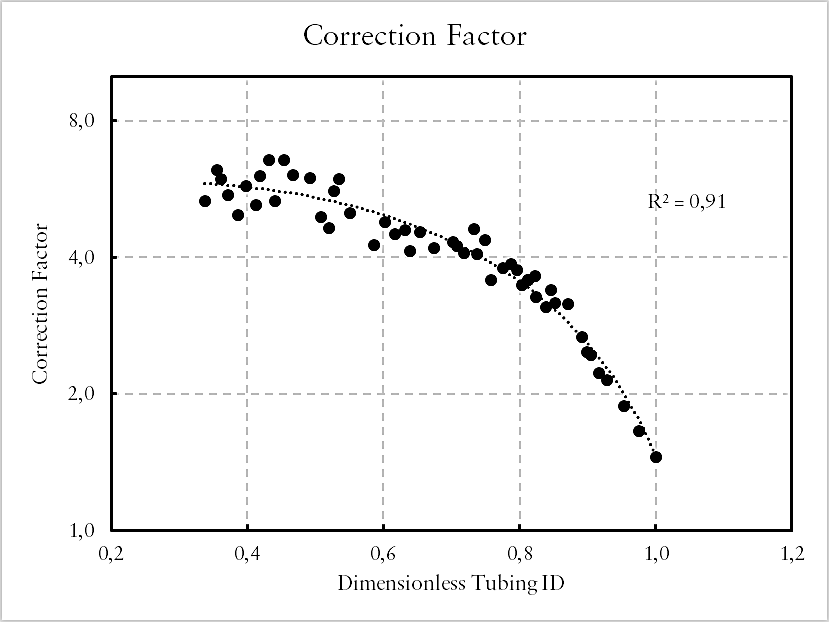Application of Mechanistic Modeling for Gas Lift Optimization: A General Scaling Curve for Variations of Tubing Size to Optimum Gas Injection
Abstract
Gas Lift is currently held as one of the most prominent method in artificial lift, proudly operated flawlessly in hundreds of oil wells in Indonesia. However, gas lift optimization is still governed by the exhaustive Gas Lift Performance Curves (GLPC). This practice, albeit as established as it should be, does require repetitive calculations to be able to perform in life of well operations. Therefore, a new approach is introduced based on the mechanistic modeling. This research highlights the application of fundamental mechanistic modeling and its derivative, the Flow Pattern Map (FPM) for quick estimation of optimum injection gas rate, accompanied by a novel correction factor to account changing tubing sizes. It is hoped that this approach can be beneficial in developing a multitude of gas lift wells with changing tubing sizes.
Full text article
References
Alarcón, G. A., Torres, C. F., & Gómez, L. E. (2002). Global optimization of gas allocation to a group of wells in artificial lift using nonlinear constrained programming. Journal of Energy Resources Technology, Transactions of the ASME, 124(4), 262–268. https://doi.org/10.1115/1.1488172
Ansari, A. M., Sylvester, N. D., Shoham, O., & Brill, J. P. (1990). A Comprehensive Mechanistic Model for Upward Two-Phase Flow in Wellbores. SPE Annual Technical Conference and Exhibition. https://doi.org/10.2118/20630-MS
Arachman, F., Utami, F., Wasonoaji, A., & Tobing, D. (2017). Brownfield Redevelopment Strategies in Offshore North West Java. SPE/IATMI Asia Pacific Oil & Gas Conference and Exhibition. https://doi.org/10.2118/186970-MS
Asheim, H. (1988). Criteria for Gas-Lift Stability. Journal of Petroleum Technology, 40(11), 1452–1456. https://doi.org/10.2118/16468-PA
Barnea, D. (1987). A unified model for predicting flow-pattern transitions for the whole range of pipe inclinations. International Journal of Multiphase Flow, 13(1), 1–12. https://doi.org/10.1016/0301-9322(87)90002-4
Betancourt, S., Dahlberg, K., Hovde, Ø., & Jalali, Y. (2002). Natural Gas-Lift: Theory and Practice. SPE International Petroleum Conference and Exhibition in Mexico. https://doi.org/10.2118/74391-MS
Cendra, D., Fitrianti, F., & Putra, D. F. (2018). The Critical Investigation on Essential Parameters to Optimize the Gas Lift Performance In “J” Field Using Prosper Modelling. Journal of Earth Energy Engineering, 7(2), 46–54. https://doi.org/10.25299/jeee.2018.vol7(2).2269
Decker, K. L. (2007). IPO Gas Lift Design Using Valve Performance. SPE Annual Technical Conference and Exhibition. https://doi.org/10.2118/109694-MS
Fang, W. Y., & Lo, K. K. (1996). A Generalized Well-Management Scheme for Reservoir Simulation. SPE Reservoir Engineering, 11(2), 116–120. https://doi.org/10.2118/29124-PA
Glass, E. D. (1975). Continuous Gas-Lift Theory (p. 7). p. 7. https://doi.org/NA
Hakiki, F., Aditya, A., Ulitha, D. T., Shidqi, M., Adi, W. S., Wibowo, K. H., & Barus, M. (2017). Well and Inflow Performance Relationship for Heavy Oil Reservoir under Heating Treatment. SPE/IATMI Asia Pacific Oil & Gas Conference and Exhibition. https://doi.org/10.2118/186187-MS
Hartono, A. D., Hakiki, F., Syihab, Z., Ambia, F., Yasutra, A., Sutopo, S., … Apriandi, R. (2017). Revisiting EOR Projects in Indonesia through Integrated Study: EOR Screening, Predictive Model, and Optimisation. SPE/IATMI Asia Pacific Oil & Gas Conference and Exhibition. https://doi.org/10.2118/186884-MS
Kanu, E. P., Mach, J., & Brown, K. E. (1981). Economic Approach To Oil Production And Gas Allocation In Continuous Gas Lift. Journal of Petroleum Technology, 33(10), 1887–1892. https://doi.org/10.2118/9084-PA
Lu, Q., & Fleming, G. (2011). Gas-Lift Optimization Using Proxy Functions in Reservoir Simulation. SPE Reservoir Simulation Symposium. https://doi.org/10.2118/140935-MS
Moissis, R., & Griffith, P. (1962). Entrance effects in a two-phase slug flow. Journal of Heat Transfer, 84(1), 29–38. https://doi.org/10.1115/1.3684284
Mukherjee, H., & Brown, K. E. (1986). Improve Your Gas Lift Design. International Meeting on Petroleum Engineering. https://doi.org/10.2118/14053-MS
Musnal, A., & Fitrianti, F. (2017). Optimasi Gas Injeksi Pada Sembur Buatan Gas Lift Untuk Meningkatkan Besarnya Laju Produksi Minyak Maksimum Dan Evaluasi penghentian Kegiatan Gas Lift, Pada Lapangan Libo PT. Chevron Pacific Indonesia Duri. Journal of Earth Energy Engineering, 6(2), 36–47. https://doi.org/10.22549/jeee.v6i2.993
Nishikiori, N., Redner, R. A., Doty, D. R., & Schmidt, Z. (1989). An Improved Method for Gas Lift Allocation Optimization. SPE Annual Technical Conference and Exhibition. https://doi.org/10.2118/19711-MS
Posenato, A., & Rosa, V. R. (2012). A Genetic Algorithm for Gas Lift Optimization With Compression Capacity Limitation. SPE Latin America and Caribbean Petroleum Engineering Conference. https://doi.org/10.2118/153175-MS
Ranjan, A., Verma, S., & Singh, Y. (2015). Gas Lift Optimization using Artificial Neural Network. SPE Middle East Oil & Gas Show and Conference. https://doi.org/10.2118/172610-MS
Samier, P. (2010). Comparisons Of Various Algorithms For Gas-Lift Optimization In A Coupled Surface Network And Reservoir Simulation. SPE EUROPEC/EAGE Annual Conference and Exhibition. https://doi.org/10.2118/130912-MS
Schmidt, Z., Doty, D. R., Agena, B., Liao, T., & Brown, K. E. (1990). New Developments To Improve Continuous-Flow Gas Lift Utilizing Personal Computers. SPE Annual Technical Conference and Exhibition. https://doi.org/10.2118/20677-MS
Shoham, O. (Society of P. E. of A. (2006). Mechanistic modeling of gas-liquid two-phase flow in pipes. Society of Petroleum Engineers.
Taitel, Y., & Barnea, D. (1990). Two-Phase Slug Flow. Advances in Heat Transfer, 20(C), 83–132. https://doi.org/10.1016/S0065-2717(08)70026-1
Taitel, Y., Bornea, D., & Dukler, A. E. (1980). Modelling flow pattern transitions for steady upward gas‐liquid flow in vertical tubes. AIChE Journal, 26(3), 345–354. https://doi.org/10.1002/aic.690260304
Taitel, Y., & Dukler, A. E. (1976). A model for predicting flow regime transitions in horizontal and near horizontal gas-liquid flow. AIChE Journal, 22(1), 47–55. https://doi.org/10.1002/aic.690220105
Tenaris. (2011). Pipe Body Performance Properties Catalogue. Retrieved October 9, 2019, from http://www.tenaris.com/en/MediaAndPublications/BrochuresAndCatalogs/OCTG/PipeBodyPerformancePropertiesCatalogueOK.aspx
Wang, P., & Litvak, M. L. (2008). Gas Lift Optimization for Long-Term Reservoir Simulations. SPE Reservoir Evaluation & Engineering, 11(01), 147–153. https://doi.org/10.2118/90506-PA
Authors
This is an open access journal which means that all content is freely available without charge to the user or his/her institution. The copyright in the text of individual articles (including research articles, opinion articles, and abstracts) is the property of their respective authors, subject to a Creative Commons CC-BY-SA licence granted to all others. JEEE allows the author(s) to hold the copyright without restrictions and allows the author to retain publishing rights without restrictions.




